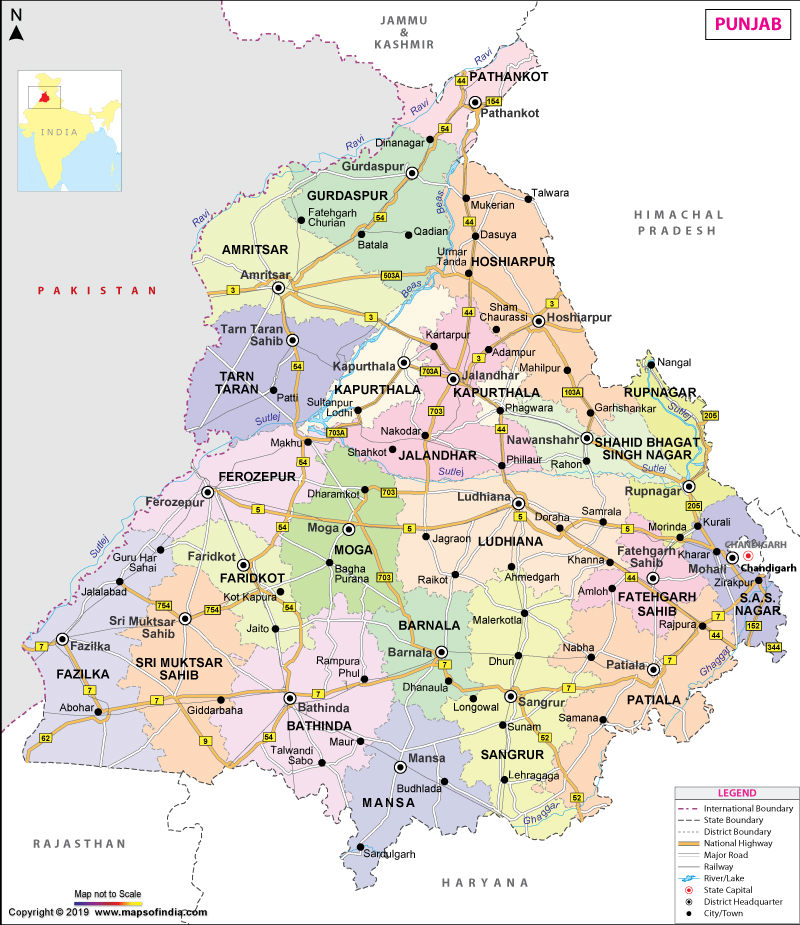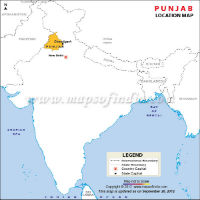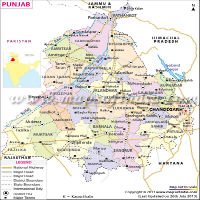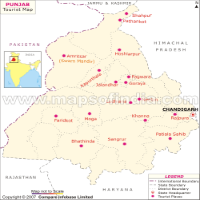About Punjab
Punjab is a well-known state in India that is located at the northwest end of the country. This state has gained recognition as the 'land of five rivers'. The five rivers are Sutlej, Ravi, Beas, Chenab and Jhelum. The state of Punjab acts as a clear demarcation of India from the neighbouring country Pakistan. The major cities that form an integral part of the state include Ludhiana, Amritsar, Jalandhar, Nawanshahr, Bathinda and Anandpur Sahib. Apart from the aforementioned cities, Kapurthala, Tarn Taran Sahib and Patiala also are situated in the state of Punjab. This state is primarily agriculture-based due to the presence of abundant water sources and fertile soils.
It is bounded on its north by the Indian state of Jammu & Kashmir, on its east by Himachal Pradesh and the Union territory of Chandigarh, on its south by Haryana and Rajasthan, and on its west by Pakistan. The city of Chandigarh is the joint administrative capital of Punjab and Haryana.
| Facts on Punjab | |
|---|---|
| Official Website | www.punjabgovt.gov.in |
| Date of Formation | Nov 1, 1966 |
| Area | 50,362 sq km |
| Density | 550/Km2 |
| Total Population (2011) | 27,743,338 |
| Males Population (2011) | 14,639,465 |
| Females Population (2011) | 13,103,873 |
| Ratio of Urban Population (2011) | 37.49% |
| No. of District | 23 |
| Capital | Chandigarh |
| Rivers | Ravi, Beas, Sutlej, Govind Sagar |
| Forests & National Park | Bir Moti Bagh WS, Harike WS, Bir Dosanjh WS |
| Languages | Punjabi, Hindi, Urdu, Gurmukhi and English |
| Neighbours State | Jammu and Kashmir, Himachal Pradesh, Haryana, Rajasthan |
| State Animal | Black Buck |
| State Bird | Northern Goshawk |
| State Tree | Shisham |
| Net State Domestic Product (2011) | 69737 |
| Literacy Rate (2011) | 82.20% |
| Females per 1000 males | 893 |
| Assembly constituency | 117 |
| Parliamentary constituency | 13 |
History
Regarding the historical background, it is possible to claim that the state primarily formed a site of the Indus Valley Civilization. Archaeological excavations performed during historical times have brought to light the fact that the cities of this state were a major part of the Harappa and Mohenjodaro, now a part of Pakistan. The Mahabharata also contained rich information about the land and people of the state. The location of the state was such that it came under constant attack and influence. The state of Punjab had to bear with such attacks from both the eastern and western regions. Different communities such as Afghans, Persians, Scythians, Greeks and Turks regularly invaded the state, thus resulting in bitter bloodshed. The culture combines the influences of different communities including Buddhist, British, Sikh, Hindu, Afghan and Islamic. Punjab suffered the most when India got divided. Most of the destruction and damage occurred in this state of northern part of India.More Detail >>
Geography
As far as the geographic aspect is concerned, the state of Punjab is located in the Northwestern part of India, encompassing a total area of approximately 50,362 square kilometers. The latitudinal and longitudinal extension of the state covers 29.30 degrees north to 32.32 degrees north and 73.55 degrees east to 76.50 degrees east respectively. The major portion of the state is situated in an alluvial and fertile plain. The fact that there are many rivers and an extensive irrigation canal system augurs well for the agricultural sector. However, it needs to be mentioned that the southwest part of the state is semi-arid and finally merges well along with the Thar Desert. You can always find the Shivalik Hills to merge well along the Northeastern part of the state. The Shivalik Hills extend till the foot of the Himalayan Mountains.
Government and Politics
The government of Punjab is the governing authority of the state. Like other states in India, the government of Punjab also has three branches - executive, judiciary and legislative. Punjab also follows the parliamentary system of government with the Chief Minister as the head of the state. There are 117 members in the legislative assembly of the state who are elected for a term of five years. Punjab sends 13 members to the Lok Sabha and seven members to the Rajya Sabha.
Education
Punjab is one of the few states that has gained recognition as one of the leading states in the education system. A recent survey has brought to light the fact that Punjab has responded in an active manner to that of the 'Sarva Shiksha Program' - a national expedition that primarily makes an effort to drive illiteracy. It indeed is an encouraging aspect that owing to the continuous effort made on the part of the Indian government, the present literacy rate stands at about seventy seven percent. There can indeed be no second thought to the fact that the tireless and continuous effort made on the part of both the central as well as the state government, quality education has been imparted to a majority of individuals. The education system is managed in a hierarchical form. The three tiers that exist in the primary education include primary education, secondary education and college education.
Economy and infrastructure
The state of Punjab has also gained true recognition among all individuals due to the presence of forestry, tourism, agriculture, industries and minerals. Livestock is also one of the other key highlights of the state. However, the state of Punjab has scarcity as far as basic minerals and fuels are concerned. This is one of the prime factors behind the poor rate of industrial development. Agriculture has been always a strong point as far as the economy of the state is concerned. The state has indeed made a huge impact in the overall economy of the country as far as production of wheat is concerned. A few of the agriculture-based industries you can always associate with the state include paper, wood, beverages and food products. More Detail >>
Demographics
The state boasts of Sikhs occupying more than sixty percent of the entire population. Some of the other communities that form a major part of the state include Hindu, Jains, Muslims, Christians and many other communities. A large part of the Sikh community that forms an integral part of the state comprise of the Jat Sikhs. In the year 2011, the population of the state was 2,77,43,338. No less than twenty percent of the entire population of the state has migrated from different regions in India. There is a constant decline in the sex ratio. The survey reveals the fact that the sex ratio has witnessed a significant drop in the last twenty years.
Society and Culture
The culture of the state of Punjab is diverse. The culture of the state bears a true reflection of the multidimensional heritage pertaining to the ancient civilizations. A majority of all tourists is equally fascinated in coming to terms with the unique charm that the festivals of the state reflect. A few of the prime ingredients that prove to be an integral part of the festival include popular dance forms, fun-loving folktales and flamboyant clothes. The festivals boast of their own unique charisma and features different forms of recreational activities such as Baisakhi, Bhangra and Gidda. A majority of all the festivals that associate with the state of Punjab bears a true reflection of immense energy. The festivals and culture seem to delight one and all tourists who plan to visit the beautiful land. The contemporary pleasures that you can relate to this particular state are a few of the other reasons behind the state being as the ultimate paradise for a majority of tourists.More Detail >>
Last Upadated on : March 10, 2025



